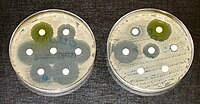
Photo from wikipedia
Pancreas ductal adenocarcinoma (PDAC) has dreadful 5-year survival of 6% and remains one of the most difficult to treat cancers with very few standard-of-care options. Fueled by the clinical success… Click to show full abstract
Pancreas ductal adenocarcinoma (PDAC) has dreadful 5-year survival of 6% and remains one of the most difficult to treat cancers with very few standard-of-care options. Fueled by the clinical success of immune checkpoint inhibitors in other solid tumors, several clinical trials have been conducted in PDAC patients. Unfortunately, those attempts have achieved limited clinical benefits as single-agent treatment. Now investigators are eager to test combinatory therapies of chemotherapies, small-molecule immune modulators, and immune checkpoint antibodies. Highly relevant preclinical models are very much needed for proof-of-principle efficacy evaluation. KPC model, first described by Tuveson and colleagues as LSL-KrasG12D/+; LSL-Trp53R172H/+; Pdx1-Cre, and later established in a variety of derivatives by several labs with Trp53 heterozygous or homozygous knockouts, recapitulates human PDAC tumors in many aspects including morphologic small ductal tumors with enriched stromal contents; key features of immune microenvironment of PDAC representing robust inflammatory reactions, like high levels of B cells and macrophages and exclusion of effector T cells; and most importantly, is nonresponsive to a series of chemotherapies and immune checkpoint inhibitors, including PD1 and CTLA4 antibodies. These features make KPC model an ideal model to test combinatory therapies for PDAC. However, parental KPC model is difficult to use for pharmacologic studies due to the spontaneous nature of tumor onset and progression. The compound mutant mice are also costly to breed. We have generated a transplantable KPC tumor model by passaging the primary tumor subcutaneously in the C57BL/6 mice. These KPC allografts retain morphologic similarity to human PDAC. Immune profiling of both subcutaneously and orthotopically grafted tumors demonstrated highly enriched CD45+ lymphocytes, particularly B cells and macrophages, in the tumor. The tumor is also nonresponsive to gemcitabine treatment, in line with the data from parental line. Orthotopically engrafted tumor leads to lethality of the host with the median survival time of 25 days. We are now testing a variety of combinatory therapies with chemotherapies, immune modulators and immune checkpoint antibodies. The results will be presented at the meeting. Citation Format: Yanrui Song, Benqi Liu, Annie Xiaoyu An, Likun Zhang, Jie Cai, Qian Shi, Henry Qixiang Li, Davy Xuesong Ouyang. Building Kras (G12D)/Trp53 null/Pdx1-cre (KPC) mouse allograft tumor model for efficacy evaluation of combinatory immunotherapies [abstract]. In: Proceedings of the American Association for Cancer Research Annual Meeting 2018; 2018 Apr 14-18; Chicago, IL. Philadelphia (PA): AACR; Cancer Res 2018;78(13 Suppl):Abstract nr 1144.
Journal Title: Cancer Research
Year Published: 2018
Link to full text (if available)
Share on Social Media: Sign Up to like & get
recommendations!